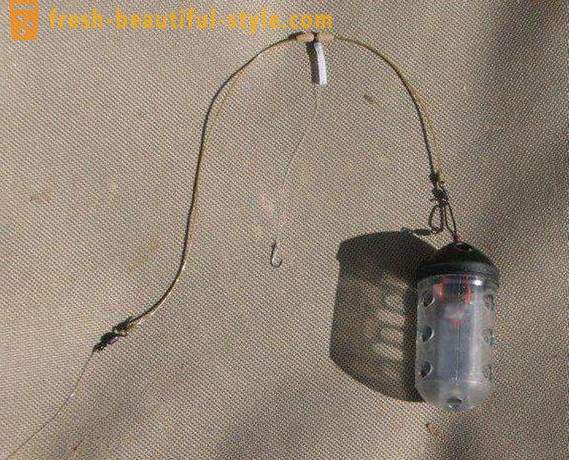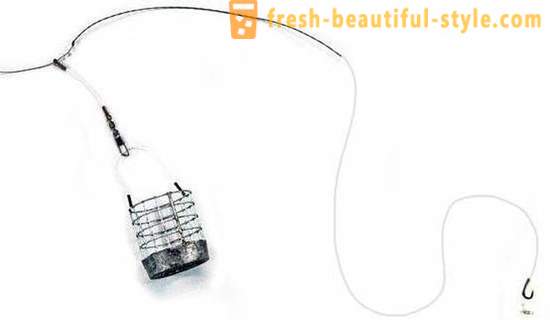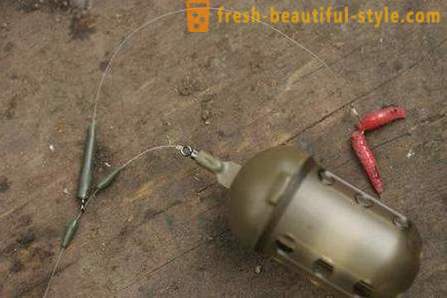Top leashes for feeder: the description, characteristics and recommendations
Going on a pond, each fisherman selects the right gear. On this depends the number of catches as well as comfort during fishing. One important element of the feeder is a leash. He plays the role of a guard against accidental breakage of line.
Leashes for feeder prevent loss of equipment at the toe or angling especially large fish. In some cases, fishermen attach the leash even on the very trough. In this case, it is easier to lose than the entire gear. What qualities should a representation of the element, will help to understand tips experienced fishermen.
General characteristics of
To do the best for the lead feeder need to consider the basic functions of the snap element. Since he plays the role of a fuse, it extends to a number of requirements. Leash should be less durable than braided or monofilament feeder rods. However, this element must not be thinner than the main thread.

In this case, it should be noted that the leashes to the feeder or any other gear are its nearest part of the fish (not counting the very hook). Therefore, it should not be noticeable. In other water inhabitants will not respond to the bait.
To make the invisible leash, need to take into account features of the reservoir. Diameter tooling must comply with characteristics of water movement. The line should be transparent, flexible and buoyant. In this case, the hook will be invisible to the fish. Therefore, when choosing represented snap member need to pay special attention to its length, diameter, breaking load and stiffness.
Breaking load
By studying how the leash on the feeder will be optimal for the existing reservoir conditions, you should first pay attention to the indicator of its breaking load. The thread should not be too thick to be invisible to the fish. However, what she was thinner, the smaller prey able to fish the fisherman.

Large fish behaves very carefully. If she noticed the line, bites will not be at all. Experienced fishermen say that only in the presence of a thin leash is possible to interest the big fish bait on the hook. The leash should not be thinner than the main line.
Experienced fishermen recommended to take into account the weight of the fish, as well as features of its behavior when angling. If the main thread is used "network" itself leash can be made of monofilament thread. In this case the main fishing line can for example have a diameter of 0, 12 mm, with a tensile strength of 7 kg. Leash same approach wherein the load at break of up to 6 kg. Its thickness may be 0, 22 mm.
diameter
When selecting equipment must take into account the weight of the fish, as well as its behavior in water. Inexperienced fisherman can tolerate errors in the calculation. For example, you want to pick up the leash on bream for feeder. It is known that there are individuals in the reservoir up to 2 kg. In the water and on the nodes yarn strength is somewhat reduced. Therefore inexperienced fisherman can assume that it will take a thread with tensile load of about 3 kg. The diameter of such a fishing line is approximately 0, 18 mm.

In the course of fishing may be that even with the stock tear bream weighing 2 kg wrench may break the thread. In the process of power production vyvazhivaniya such a situation is not uncommon. Inexperienced fisherman in this case, replace the leash. The diameter of the new thread will be about 0, 22 mm. Breaking strength increase of up to 4 kg. However, this is tackle bream get round. With this method of fishing experienced fishermen recommend to reduce filament diameter of 0 to 14 mm (tensile load 2, 5 kg). White bream to fish with a tackle not be easy. For bream require some skill.
length
Uniform rule for selecting the length of the leash is not. It is necessary to take into account the fishing conditions and of the pond. Most often used snap 12-15 cm long. It may be longer. Some fishermen use leashes up to 50 cm. In order to understand how to choose this feature, you should look into the principle of feeder fishing.

Feeder delivers food in the area of fishing. It does not attract fish. Cloud feed water forms an oval zone. She pulled down the river. This loop will be the bait. Leash for the feeder current is drawn. When biting stirring equipment may scare off the fish. Therefore leash loop must be longer bait. Therefore, the stronger the current, the longer it may be the leash.
When fishing is carried out in standing water, lead sink to the bottom without stretching. To feel the bite, it is necessary to have a short snap. In the process of selecting the length, you must also take into account the operation rod. If it is fast, the leash should be shorter. Choose the correct length can be in a pond. It is necessary to pay attention to the bite. If noticeable even small movements, so this figure is chosen correctly.
The stiffness of
The length of the leash to the feeder is one of the main parameters of this gear. However, it should also be considered while its stiffness. The higher the score, the more sensitive will snap. However, when a high value of this parameter may be determined unnatural bait game. Fishing lines will look like on the wire flow. Careful fish is necessary to notice, lose interest in the bait.

At the bottom of the flow will be much weaker than on the surface. In some reservoirs at a depth of it non-existent. Therefore, the hard leash will give a sensitivity snap. Too soft bait fishing line games will not be at all. Therefore, when choosing hardness of the leash, it is necessary to take into account its length. The smaller it is, the softer material may be a thread.
One of the most popular materials for the leash is a fluorocarbon. He has a high stiffness. This thread does not lose this characteristic even with prolonged stay in the water. The breaking strength of the material is less than conventional fishing lines at equal diameters. The visibility of the thread material is represented by a factor of 2 smaller.
Color
Determining how long a leash on the feeder will be optimal for different fishing conditions, as well as selecting an appropriate rigidity, it is necessary to pay attention to the color of the thread. This will depend on the invisibility of equipment in the water. Most often these goals become clear fishing line. She did not notice even in clean, clear water.

Experienced fishermen say that the more inconspicuous tackle is a thread which is painted in various shades of blue. Also suitable brown, green shades. The color of the water in a river or lake must be considered before selecting the thread. For small swampy rivers or lakes suitable green fishing line. In pure water is inconspicuous blue thread. If you pick up at a great depth, it is possible to give preference to brown or even black. Fish does not distinguish colors. However, contrasting the leash may frighten her. Only becomes invisible snap catchability.
Braids Monofilament or
Color, leash stiffness and length of the feeder determines the effectiveness of the equipment. However, when choosing recommended to take into account the structure of the thread itself. In various embodiments presented commercially braided and monofilament cords. The choice in this case is obvious.

If we consider that one of the main requirements for the leash is its lower tensile strength and a larger diameter than the warp thread, then an option in this case would be a monofilament. Braided cord has a smaller diameter at the same tensile load. He does not stretch, so he is not able to absorb shocks at jerks fish. This task will fall on the main thread.
In some cases, when angling for the jerks may be absorbed by the rod. If it refers to the fast action, large fish can not only break the main line, but also to break itself form. To avoid such unfavorable outcome, should be used to the leash monofilament.
Fidergam
Leashes for feeder often made with the assistance of a special thread called fidergamom. It is made of a rubber material. It includes latex. Fidergam applied as an insert between the main shaft housing and snap. It is able to well absorb the jerks big fish. Going on fishing, for example, bream, this material is simply irreplaceable. This insert must stretch before reaching the maximum breaking load of the leash. With a strong jerk must tear fidergam. In some cases, breakage occurs in the lead. Therefore load capacity of the insert should not exceed the figure for the tooling.
The best is characteristic fidergama at which its maximum extension will be 10-15% more than that of lead. Prior to its termination paste spread over 40 cm. This is sufficient to absorb the jerk big fish. When using the material presented can not adjust the friction brake coil accurately.
Leashes own hands
Going on a fishing trip, you need to learn how to tie a bird feeder and leash on the feeder, and make snap their hands. Such work will be able to perform even a novice fisherman.
Leash is a consumable material. He can terminate. In the process of fishing you need to choose the optimal equipment. Therefore, before going to the nature, it is recommended to prepare several copies of the thread. They have different length, thickness and color. Set leashes should include segments from 30 to 70 cm. Also, take into account what size will the hooks.
The line should be of different diameters. Her selected according to the type and size of the fish, which is found in the river or lake. It is necessary to take into account that the thread does not have the "memory effect." This will allow a snap responsive to bite.
The choice of the hook
There are many ways to tie the feeder and leash on the feeder. Every fisherman selects a node that is most convenient to him to create. The main thing is that it is reliable. In these places, inventory is the most vulnerable. Therefore, the selected node must be durable, reliable. Hooks for the feeder is not very large in size. Most often used for this purpose snap under number 10-16. It is important to pay attention to the quality of the hook. It should not be bent, have defects, traces of rust. You need to purchase a few different hooks. This will allow the field to choose the best type of equipment for the feeder.
Hooks should be well sharpened. Qualitative varieties made from hardened steel
leash Knitting
Consider what materials are needed for the manufacture of tooling, we can consider the procedure as knit leashes on the feeder. There are certain rules of combination of hook and fishing line. It is recommended to select materials in accordance with established, proven empirically right.
For hooks numbered 16-14 suitable thread diameter 0, 12 mm. If it is 12, suitable monofilament 0, 14 mm. № hook 10 is intended monofilament diameter of 0, 16 mm.
After considering especially the selection and creation of leads for the feeder, it is possible to independently produce suitable tooling.













































